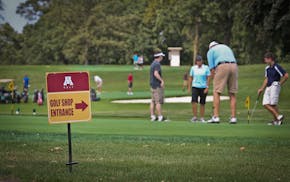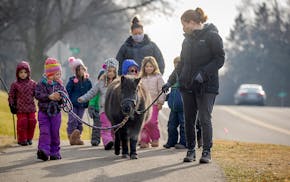NORTHFIELD – As students at St. Olaf College buzzed through the Buntrock Commons on a golden October evening, a pair seated at a folding table called out:
"Are you registered to vote?"
At St. Olaf, the answer is almost always yes, with nearly 90% of eligible students registered, either in their home states or in Minnesota. The college's robust voter turnout team of more than 100 volunteers helped lead to the highest rates of voting of any college in the country in 2020, but other campuses are also working to make sure students participate in this year's election.
Nonpartisan campus groups are adding to the work of college Democrats and Republicans to urge students to vote, and to make sure they feel informed on state and local races.
"When you're younger, sometimes you're told that your voice isn't going to be heard," said Sophie Smith, a third-year dance and political science major who is helping lead St. Olaf's voter turnout work. "We're trying to make sure people know it's worth it."
Vote work
Young Minnesotans vote at higher rates than young people almost anywhere else in the country, according to a recent Tufts University analysis, with youth vote turnout among the top three states in each of the last three national elections. But that's not solely because of Minnesota's overall high voter turnout rates. Smith and St. Olaf's two other student vote coordinators, Elijah Sonntag and Roxi Wessel, are paid by the college to organize a cadre of other student volunteers, and to coordinate on-campus voter education work. They also help students who want to vote absentee in their home states, helping them figure out what it takes to vote by mail.
Turnout drives like the one at St. Olaf are taking shape at other colleges too. At Minnesota State University-Mankato, Lily Mohr and Lili Ceballos are working to persuade fellow students to vote this year, in a program they hope will continue and expand.
"Most people are already registered to vote," Mohr observed. "Actually getting those people to go to the polls is a whole thing in and of itself."
Ceballos said she wanted to help other students vote because she grew up in a home of nonvoters.
"It was important for me to tell people who grew up the same way as me that voting exists and your voice does matter," she said. Both Mohr and Ceballos will be voting in their first presidential election, having both turned 18 just a few days after the 2020 election.
Mankato political science professor Fred Slocum said he hopes students are less cynical about politics if they feel like their input is important in the outcome of a race.
The state's college students will likely not have an impact on statewide races, and they are unlikely to swing a congressional race. But students voting in legislative and local races could make a difference, Slocum said.
Down-ballot focus
Though some students have not considered voting at all or have only thought about the top of the ticket, another goal of the St. Olaf group is ginning up interest in down-ballot races. These more local contests are ones where the student vote could make a difference, said St. Olaf political science professor Chris Chapp.
Northfield, for example, sits in the competitive Second Congressional District, which is more likely to be determined by voters in the Twin Cities suburbs than by the Carleton College and St. Olaf vote. But those college voters could have an impact on city council races, so St. Olaf has brought council candidates to campus to help students learn about their platforms.
Sonntag, a Wisconsin native, decided to vote in Minnesota this year even though his vote might have made a bigger impact in the Badger State. "You're supposed to vote where you consider home," Sonntag said, and he's become interested in the city council races and Northfield's three school funding referendums.
Among voters of all ages, Chapp said, more people vote the top of the ticket than in down-ballot races.
"That's where providing voter education is important," Chapp said.
On other campuses, college turnout could have an impact in the closest legislative contests.
Gustavus Adolphus student Lissie Artley is involved in the college's voter turnout efforts, and said she sees a lot of interest on campus in the race for St. Peter's House District 18A, between DFL Rep. Jeff Brand and Republican Erica Schwartz.
"People are actually pretty into it," Artley said. She said students are getting most of their information about the race from Instagram and TikTok, ads on YouTube and by looking at the candidates' websites.
She sees much more engagement with the legislative contest than there was in 2022, and more interest in races up and down the ballot.
"I think everything feels really high stakes right now," she said. "We watched 2016 happen and we watched, even down to the local levels, changes none of us would have expected."
Now able to participate in a presidential election, many for the first time, Artley said her peers are eager to apply their years of political observation to participation.
Other students who plan to vote in their hometowns are focused on local races. At St. Cloud State, art education major Erika Johnson said her classes have been talking a lot about how school board races will impact their future jobs. Johnson said school funding is one of her top issues this year, and she's looking forward to voting in a school board race in her hometown of Buffalo.
Chapp said he sees student voters are tuned into politics, but not fans of any politician in the way millennial voters latched onto former President Barack Obama's candidacy in 2008.
"I think they care deeply and are deeply interested but they're deeply exhausted," Chapp said of today's students. "The attitude among a lot of students is they're engaged, they're going to run out to vote," he said, but they may not be engaged beyond that.
When she encounters those students exhausted by politics, Mankato's Mohr said she urges them to vote in the less-polarized down-ballot races.
"At least go to the polls and vote for your judges and school boards."
Erin Adler contributed to this report.
Supreme Court allows DOGE team to access Social Security systems with data on millions of Americans

Thompson found guilty of murder in car crash that killed 5 young women

University of Minnesota is putting its golf course up for sale
Feeding Our Future probe: Apple Valley woman charged with defrauding food program of $1.4 million

